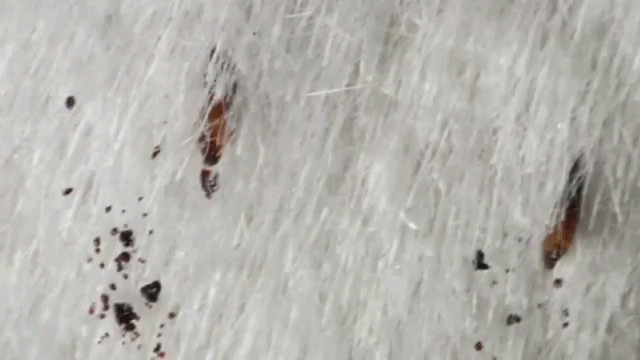Summary
Adult fleas live on animals. They’re permanent parasites and rarely leave after acquiring a host. Once feeding begins, fleas become dependent on host blood. They’ll die within 4 days of being removed from the animal. Also, without continual feeding, females can’t lay eggs.
Fleas prefer living on the back, neck, and ventral (underside) regions of dogs and cats. It’s rare to find fleas on legs or tails. The host’s grooming habits influence where fleas live.
Details
Fleas Live on their Host Animal
Permanent Ectoparasites
Cat fleas have developed a persistent relationship with their hosts. Once on an animal, both sexes become permanent residents and rarely leave of their own volition. Therefore, they’re classified as permanent ectoparasites.

Img 1 Adult cat fleas live on their host. Once a host is acquired, it’s rare for them to leave voluntarily.
Fleas feed, mate, and lay eggs directly on their host Img 1. This activity continues until they’re dislodged or die, which usually occurs from host grooming.
Transferring Hosts
It’s a common misconception that fleas jump on and off their current host, or leave to acquire a new host. Fleas rarely transfer hosts. When two cats live together but are separated, 3-8% of fleas transfer between them. When they aren’t separated, 2-15% of the fleas transfer hosts. When grooming is restricted, 85% of female and 58% of male fleas remain on their host for at least 50 days.
Abandoning Hosts
Fleas stay on their host even when corporeal populations reach high levels. Some researchers believe fleas will abandon a host when the population reaches 200-300 fleas. However, another study saw no abandonment even when this threshold was passed. Regardless, flea populations this high are rare and only occur in extreme infestations.
Fleas will quickly leave a dead or dying host. Once the host’s body temperature begins dropping, fleas start jumping off the animal.
Host Blood Dependence
Undernourishment
Within 24 hours of feeding, a previously unfed flea will double in weight and triple in soluble protein content. When it’s removed from the host and starved for 12 hours, all of the gained weight and most of the protein is lost. Thus, in order to prevent undernourishment, fleas must feed at least every 12 hours.
Starvation
After feeding for a few days, a threshold is reached where fleas become dependent on a constant source of blood. If they’re removed from the host after feeding for 5 days, males die within 48 hours and females die within 96 hours. Generally, fleas starve within 4 days of host removal. Egg-producing females may die in as little as 24 hours.
Reproduction
After the first blood meal, females must continue feeding in order to keep their metabolism in balance for egg production. As an adult, a female’s main purpose is to reproduce. It must remain on its host and feed constantly in order to fulfill this function.
Where Fleas Live on Pets
Fleas prefer living on specific body regions of dogs and cats. The highest concentrations live on the lower back, neck, and belly area of pets. Very few will be found on the tail and legs Img 2.

Img 2 Heat map showing where fleas live on dogs and cats. Cats tend to have more fleas living on their head and neck, and dogs have more on their underside.
Fleas on Cats
On cats, most fleas live around the neck area. In one study, 45.7% of fleas on cats were recovered from their heads and necks. The back (dorsal) region was the second-most infested area, followed by the belly Fig 1. Another study’s findings were similar. Veterinarians also report the neck area as harboring the most fleas on cats.
Fig 1 Mean percentage of fleas found (y-axis) on different regions of cats (x-axis).
Flea allergy dermatitis (FAD) in cats commonly develops around the neck and lower back. It may also occur on the abdomen, behind the ears, and around the hind legs. However, the allergic reaction can be systemic, so it doesn’t necessarily occur where fleas bite.
Fleas on Dogs
Compared to cats, dogs are less likely to have fleas on their necks and are more prone to having problems on their undersides. In one survey, the most heavily infested areas were the back and sides, followed by the chest and abdomen. The neck and crotch were moderately invested. A similar study found fleas were most prevalent around the hindquarters of dogs.
In dogs, FAD is most prevalent on the dorsal lumbar region (lower back), followed by the hindquarters (tail base, thighs, and groin).
Effects of Host Grooming
The leading cause of death for adult fleas is host grooming. As a result, grooming behavior influences the on-host distribution of fleas. Most fleas live in areas where it’s difficult for animals to groom themselves.
Where Fleas Live before Finding a Host
Only adult fleas are parasitic. The eggs, larvae and pupae live off the host. In homes, immature stages typically develop at the base of carpets in rooms where pets frequently rest. After pupating, adults can remain quiescent inside their cocoons for months. Once emergence is triggered, fleas exit their cocoons and move to the top of the carpet canopy where they’re able to jump onto a passing host.
Light and visual cues are important for host-finding. Prior to acquiring a host, emerged adult fleas tend to gather near openings that allow light in. Common examples are vents, crawl spaces, window sills, and dog house entrances.





You must log in to post a comment. Log in now.